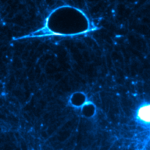Link to Pubmed [PMID] – 27043629
Toxins (Basel) 2016 04;8(4):101
The pathogenic bacteria Clostridium difficile, Clostridium perfringens and Clostridium botulinum produce the binary actin ADP-ribosylating toxins CDT, iota and C2, respectively. These toxins are composed of a transport component (B) and a separate enzyme component (A). When both components assemble on the surface of mammalian target cells, the B components mediate the entry of the A components via endosomes into the cytosol. Here, the A components ADP-ribosylate G-actin, resulting in depolymerization of F-actin, cell-rounding and eventually death. In the present study, we demonstrate that 4-bromobenzaldehyde N-(2,6-dimethylphenyl)semicarbazone (EGA), a compound that protects cells from multiple toxins and viruses, also protects different mammalian epithelial cells from all three binary actin ADP-ribosylating toxins. In contrast, EGA did not inhibit the intoxication of cells with Clostridium difficile toxins A and B, indicating a possible different entry route for this toxin. EGA does not affect either the binding of the C2 toxin to the cells surface or the enzyme activity of the A components of CDT, iota and C2, suggesting that this compound interferes with cellular uptake of the toxins. Moreover, for C2 toxin, we demonstrated that EGA inhibits the pH-dependent transport of the A component across cell membranes. EGA is not cytotoxic, and therefore, we propose it as a lead compound for the development of novel pharmacological inhibitors against clostridial binary actin ADP-ribosylating toxins.

